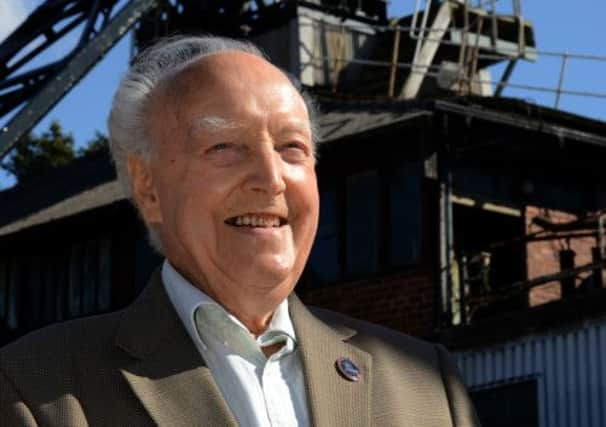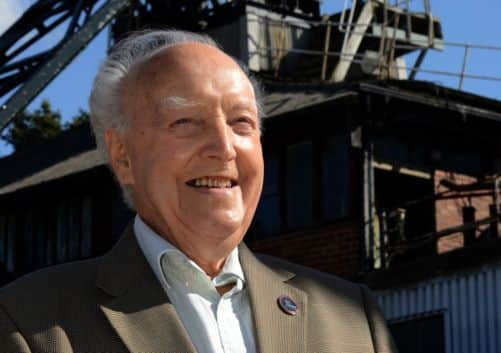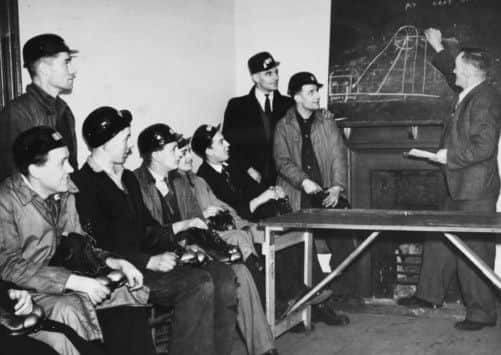Paying tribute to the miners who dug deep for war effort


Back in 1943 Britain faced a coal production crisis with as little as three weeks supply left available. Not only did this threaten to grind industry to a halt at home, it put our war effort in jeopardy just as the momentum was swinging in the Allies’ favour.
In a bid to boost production and avert disaster young men were sent to work down the mines by Ernest Bevin, the wartime Minister for Labour and National Service. He decided that one in 10 conscripts aged between 18 and 24 drafted to serve in the armed forces would – on pain of imprisonment and irrespective of their background or ability – go and work in Britain’s coal mines.
Advertisement
Hide AdAdvertisement
Hide AdAround 48,000 Bevin Boys, as they came to be known, took on unskilled manual jobs to allow more experienced miners to concentrate on production at the coal face. The conditions they faced were dangerous, and potentially fatal, yet many of them were branded as cowards for not going off to fight. They didn’t get medals when they were demobbed and, for many years, their efforts were overlooked or ignored.


In recent times their contribution to Britain’s war effort has attracted more attention and these “forgotten heroes” have begun to get the recognition they deserve. However, their numbers dwindle with each passing year and next month the National Coal Mining Museum, near Wakefield, launches a new exhibition highlighting their bravery and chronicling their stories.
A Bevin Boy in Yorkshire features the art of former Bevin Boy, Martin Hill, who trained at Birley Colliery in Sheffield before moving to Bretton Colliery in Barnsley. Hill died in 2005, but his letters, diaries and artwork offer a fascinating insight into life down the pits. The exhibition has also been gathering stories about the experiences of the young men who went down the pits, the romances that blossomed between them and some of the local girls and the memories of those who took the young Bevin Boys in as lodgers, to help create an oral history.
Among these is 87 year-old Bill Pratt, from Mirfield, in West Yorkshire, who was conscripted to work down the pits during the war. He grew up on his father’s farm near Appleby, in Cumbria, but in 1942, at the age of 16, he joined the Air Training Corps after setting his heart on joining the RAF.
Advertisement
Hide AdAdvertisement
Hide AdSo how did he end up as a Bevin Boy working deep underground? “It was my own fault that I got into the pits in a round about way,” he says. When it came to his call up in 1944 he passed his army medical and spent three days in Doncaster where he sailed through a series of Air Crew selection board tests, only to be told his colour vision was faulty, dashing his RAF dream. “I was devastated,” he says.


“But it probably saved my life because 50 per cent of air crews never came back, so if I had joined the RAF I’d be lucky to be here today talking to you.”
Instead, he was told he’d either end up in the Army or down the pits and in November that year he was told to report to Annfield Plain, a village in County Durham, where he was given a month’s training. “You had a little bit of choice over where you could go and I looked for the place nearest to home which was Ferryhill and as luck would have it I managed to get in a colliery there.”
To begin with he did all kinds of unskilled “monotonous” jobs before being sent to work underground, which came as something of a culture shock. “It was noisy and dirty and sometimes it was cold and wet. But if the seam was deep and dry clouds of dust rose up so you were black before you even reached your place of work. There was no health and safety in those days,” he says, with a chuckle.
Advertisement
Hide AdAdvertisement
Hide AdHe was billeted to a hostel along with fellow Bevin Boys who came from came from all over the country. “It was interesting, especially living in the hostel because you were in with youths from various walks of life and you learned a lot.”
Bill says the Bevin Boys mixed well with the locals and their fellow miners.
“You might get the odd remark from some of the younger generation, but they were working down the pits and they had no prospects of coming out, whereas they knew the Bevin Boys would only be in for a year or two and then they’d be out. So sometimes they felt a little bit peeved, but most of the time people were helpful.”
Working in the mines could dangerous whatever your job and injuries, particularly to hands and fingers, weren’t uncommon. Bill himself had a lucky escape while working on a new coal face. “A new machine was hacking away at the stone which was being sent back on conveyor belts and from there to tubs. But it kept falling off the belts and we had the job of putting it back on,” he says.
Advertisement
Hide AdAdvertisement
Hide Ad“One morning the place was what’s called ‘on the work’, in other words it was moving. The timbers were cracking and today you’d be sent straight out, but back then you carried on. All I remember is that one of the giant girders supporting the roof jumped out and hit me on the head. The next thing I was coming to on a stretcher and being carried out and I remember someone saying ‘thank God, he’s still alive.’ Luckily, I had my helmet on because a lot of the men didn’t like wearing them because they were uncomfortable and made you sweat,” he says.
“These days they’d have you in hospital but there was none of that, they took me back to the hostel and put me in bed and sent for the local doctor. He said I was badly shaken up but nothing was broken and I was told the best thing was to stop in bed for a day or two.”
Despite this lucky escape he says he and his fellow miners didn’t worry about accidents. “After a while you didn’t think about it, there were always bits of stone dropping on you but it was just part of the job.”
Sometimes the biggest danger was from the machinery itself. “There were two kinds of haulage, one was a main and tail where they put 10 tubs together with a fire rope at the front and the back and it was hauled by an engine to the shaft.
Advertisement
Hide AdAdvertisement
Hide Ad“But sometimes this would break loose and all you’d hear was this noise and everyone would jump to the side into one of the man holes and when it came rocketing past you just hoped it didn’t come off the rails. But that happened quite often which was a bit frightening.”
He left the pits in the summer of 1947 after two-and-a-half years and returned briefly to farming before get married and moving to Yorkshire in 1955, where he worked in the insurance industry until retiring in 1986.
For a long time, though, the Bevin Boys have been misunderstood and there are still people who believe, quite wrongly, that they were pacifists who got an easy ride, when in fact it was completely random who got selected.
Bill says it took a long time before they started to receive recognition. “We were unheard of and with us not having uniforms I think a lot of people thought Bevin Boys were conscientious objectors. I never had that thrown at me but I’ve heard from plenty who did.”
Advertisement
Hide AdAdvertisement
Hide AdLooking back at his days as a Bevin Boy he says he hopes they made a difference. “The government made the mistake of letting the miners join the forces and a lot of miners, once they saw the chance to get out of the pits, were off. But all of a sudden they realised there was a shortage of coal and the first Bevin Boys were conscripted in December 1943.
“There was only two or three weeks coal left in the country but whether we helped to save this I don’t know, but we must have contributed something.” They certainly did.
A Bevin Boy in Yorkshire runs at the The National Coal Mining Museum, from October 14 to January 26, 2014. To get in touch with the museum and share a story relating to the Bevin Boys in Yorkshire visit www.ncm.org.uk
Bevin Boys: The forgotten wartime heroes
The Bevin Boys were so called after Ernest Bevin, Minister for Labour and National Service, who came up with the idea to conscript workers into the mines and supply vital coal to British industry from 1943 to 1948.
Advertisement
Hide AdAdvertisement
Hide AdCoal for fuel and power was essential to boost the war effort. The Prime Minister Winston Churchill called for greater production but there were too few miners, so in 1943, in an attempt to increase production, Bevin decided to conscript young men into the coalfields.
One in ten of all conscripts aged between 18 and 24 had to work at coal mines through the Bevin Boys scheme. For most young men, who expected to join the forces, it was not a popular choice.
Approximately 48,000 Bevin Boys (as they came to be known) undertook unskilled manual jobs to allow the more experienced miners to move on to coal production at the coal face.
For a long time their efforts were overlooked and forgotten, with many people in this country believing, wrongly, that they were either conscientious objectors or pacifists.
Advertisement
Hide AdAdvertisement
Hide AdThe Bevin Boys Association was formed in 1989 to recognise the contribution the miners made to their country during the Second World War.
In 1998, representatives from the association were allowed to take part in the Remembrance Day Parade at the Cenotaph for the first time.